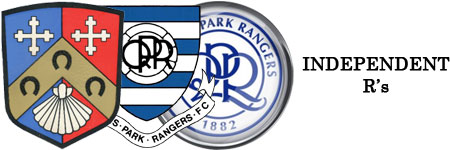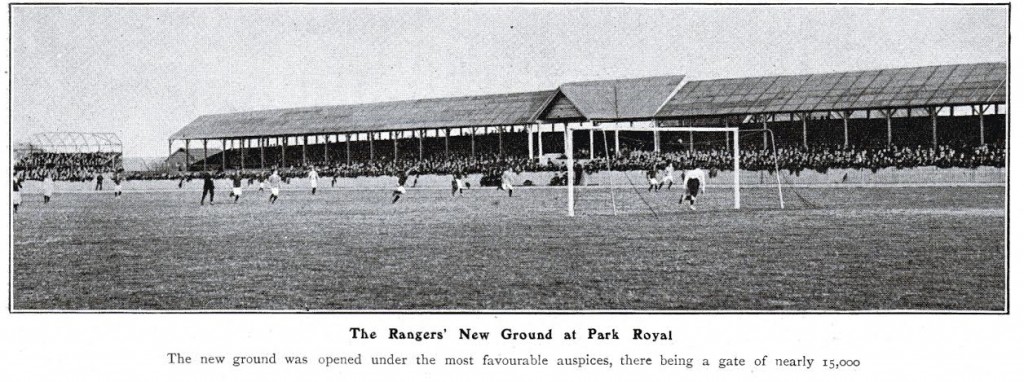The following fascinating article was written by J.V.A. Kelly and appeared in the Great Western Railway magazine in 1904:
‘Park Royal sprang into prominence like a streak of lightning as the permanent head-quarters of the Royal Agricultural Society and with equal suddenness it seemed likely to disappear from notoriety when in June last that society’s annual show for a second time proved a financial failure.
At that time, however, the directors of the Queen’s Park Rangers Football Club were at variance with their landlord at the Kensal Rise Athletic Ground and it became incumbent upon them to adopt a new playing arena for the season 1904-5.
When Park Royal was suggested as a convenient head-quarters, ninety-nine out of every hundred of their regular supporters asked, “Where is Park Royal?”
But at the practice matches played in August last it was evident that a large number had discovered the locale, as the crowds which watched those matches were very much above the average in point of numbers.
The question of reaching Park Royal from the Kensal Rise District, whence hail the backbone of the Rangers’ support, was an important one: houses in the Brent Valley district are few in number, and therefore the whole of the patronage is a floating one, principally governed by the presence in town of such rival clubs as Fulham and Brentford, which provide counter attractions.
“Nothing succeeds like success,” but a bad start from the Rangers’ point of view was made when the L. & N.W. Company showed reluctance to initiate a through service of trains from the North-West London district to their own station at Park Royal which is only of a temporary character; thus the whole of the transport arrangements had to be made by the G.W. Company.
Here was an opportunity for the Great Western to show the general public that they possess an organisation capable of affecting the convenient and comfortable transport of large crowds between different points in a minimum of time.
Arrangements were accordingly made for the running of special trains at low fares from Paddington and Westbourne Park, Kensington (Addison Road) and the West London Extension Line, in addition to the supplement rail motor services from Ealing and Southall; while now, when the season has advanced the L. & N. W. Company, awakening to the possibilities of a service of football specials to Park Royal , have been induced to co-operate with the G.W. Company in running through trains from North London.
Queen’s Park Rangers are principally concerned in the Southern League, which ranks third in the football world, the League Championship Divisions 1 and 2 predominating in importance; although it is an open question whether the class of play produced by the Southern League clubs is one which is inferior to that of the Football League teams.
In Southern League matches Queen’s Park Rangers attract an average crowd of about twelve thousand spectators, of which a large proportion are carried by the Great Western Company. Of course, the status of the visiting club in southern football circles largely affects the “gate” at Park Royal, but the crowds, so far as the new arena is concerned, are capable of development, and, reading the signs, this expansion is not unlikely to materialise.
For the first year of their existence Queen’s Park Rangers have been excused the qualifying stages in the competition for the English Cup and when the competition proper is reached this month, it is quite possible that a First League club of considerable importance will be drawn against the Rangers.
It is doubtful whether, in the Southern League, the Rangers are ever likely to draw a larger number of spectators than 20,000, but the directorate may at some time be induced to enter the English League and in the event of admission being gained to the First Division, powerful rivals, such as Aston Villa, Sunderland, Everton, Liverpool, or the many other clubs equally famous would prove so attractive that the spectators would rarely fall below an average of 25,000 per match; the ground for such an assumption being afforded by the enormous crowds which flock to Plumstead in support of Woolwich Arsenal since their attainment of First Division honours.
As the head-quarters of a first-class football club, Park Royal leaves little to be desired. The playing area, which is the horse ring for Royal Show purposes, has been formed upon thoroughly up-to-date principles and it would be difficult to name a ground having a more rapid power of recovery after a period of wet; indeed, one might go so far as to say that even the famous enclosure at the Crystal Palace – the scene of the English Cup final tie for some years past – would be unplayable at a time when the Park Royal ground had resumed a practically normal condition.
With regard to the accommodation for spectators, it has to be borne in mind that the present arrangements were necessarily carried out in a hurried manner, but, even so, the stands which have been erected on both sides of the ground adequately meet the demands of ordinary club football.
Much, however, remains to be done to adapt the place to the demands of, say, an international match, but the space at disposal is capable of such development as to accommodate the largest football crowd on record; it is, in fact, debatable whether, if the greatest possible accommodation were provided, a gathering would be forthcoming for any event to necessitate its full utilisation.
Abler pens than mine have advocated the desirability of the Football Association acquiring Park Royal, primarily for the playing of the English Cup final tie, which after all holds pride of place in the hearts of football enthusiasts, and the fact cannot be gainsaid that in most respects the advantages of the site for this purpose far outweigh those which can possibly be advanced in favour of the Sydenham ground, the principal being the question of main service.
The financial success of the event depends, as all such events must do, upon the general sporting public, and it is not going too far to say that the unique attractiveness of the Crystal Palace itself is mainly responsible for the mighty crowds that yearly flock to the Sydenham heights.
Comparisons are odious, but it has, nevertheless, to be admitted that the bugbear of the Palace on “Final day” is the tedious rail journey from and to the metropolis. It matters not what teams constitute the finalists, the Midlands and the North furnish an enormous proportion of spectators who are conveyed by all the northern companies.
The Great Western Company alone, with its 2,718 miles of railway and serving such hotbeds of football as Reading, Southampton, Swindon, Bristol, Birmingham, Wolverhampton, South Staffordshire and even Plymouth, being responsible for a very large quota of these annual visitors from the provinces.
True, a large number are conveyed to their destination by through trains, but the bulk are deposited at the London termini and find their way southward at their leisure. How much more easily could these latter reach Park Royal! And even far superior facilities present themselves for through trains working from the north than is the case with the Crystal Palace, while the conditions are all in favour of the running of through trains from the southern lines if desired.
Park Royal station itself is of an exceedingly commodious character, and its appointments generally are of a very liberal description. There is, moreover, a very extensive yard within the show grounds, served by a direct entry from the Acton and Wycombe line, with lengthy sidings alongside which temporary platforms could be erected for dealing with the longest excursion trains.
Much eulogy has been forthcoming from the football public and contributors of sporting articles in the Press in respect of the admirable and expeditious football train services, to which reference has already been made, and it is pleasing to be able to record that the arrangements made by the responsible officers of the Company in this direction are highly appreciated by the public, who recognise the ability of the Great Western Company to cope with a special description of traffic within a restricted period of time in a manner far in advance of anything hitherto experienced at the hands of other railway companies within the precincts of the metropolis.
The wide experience of the Company’s officers and their subordinates in handling large crowds tends to the assurance of their ability to conduct a “final day” business with expedition and success, and given a fair and impartial consideration, it is beyond question that Park Royal must justify its claims to rank as one of the best and most convenient, if not absolutely the premier, football ground in the kingdom.’
This move in the summer of 1904 clearly demonstrated the ambition the club had during this period of our history.
And in November 1907, Rangers moved half-a-mile or so up the road to a new, even bigger stadium situated adjacent to Park Royal Station.
Rangers were Southern League Champions in 1908 and their bid to attain Football League status was thwarted when Tottenham Hotspur were surprisingly admitted despite finishing in 7th place and 10 points behind the R’s!!!
Steve Russell
(My thanks to Martin Percival, Colin Woodley and Gordon Macey for their assistance in making this article possible)


Thanks Steve – good reading. I’m looking forward to reading the follow up piece from 1907
The main Park Royal stadium with a station attached was yet anther stadium that got away and if we had kept it things would have taken a totally different course.
Fascinating time in our history and a period that has given Steve, Kerrins and I great fun researching.
Just imagine how Park Royal could have been developed over the decades!
Shame really that matters never worked out…but I guess if events had turned out differently most of us today could have been supporting Shepherds Bush FC!
Just for clarification purposes – the first image is from the second Park Royal Stadium (1907 to 1915) and the second one from the first stadium (1904 to 1907)